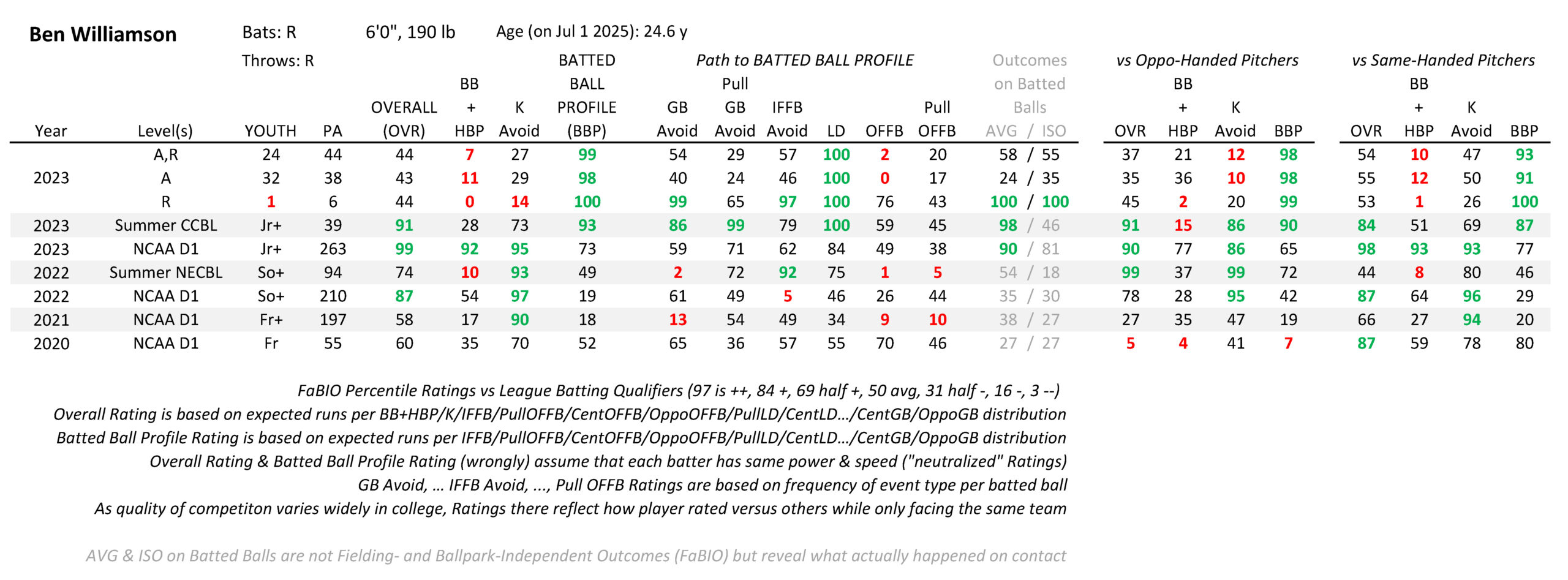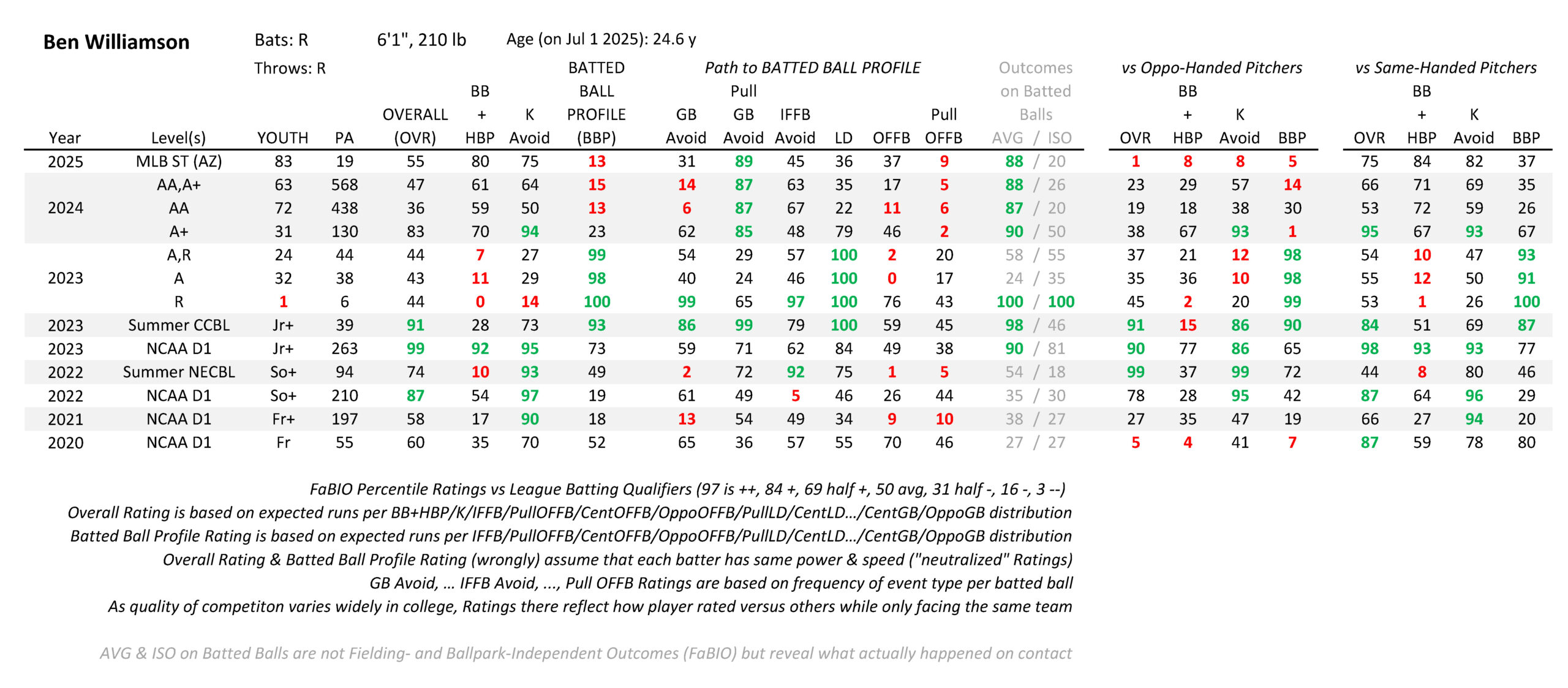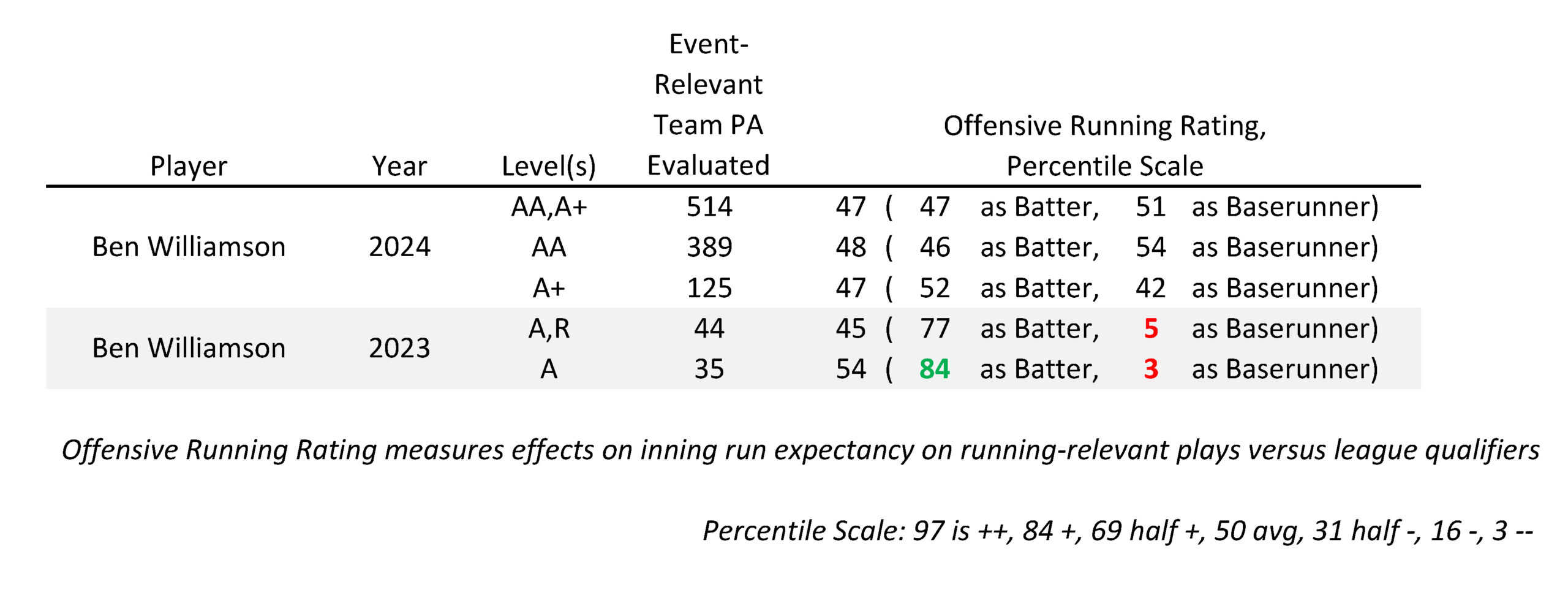
Ben Williamson's fantasy baseball prospect outlook, bust potential for dynasty leagues. Matt uses his custom suite of fundamentals-rooted evaluation tools.
With his recent selection to the major league roster of the Seattle Mariners, Ben Williamson becomes who I believe to be the fifth 2025 MLB rookie position player from the 2023 MLB Draft class.
Long a strikeout avoider, Williamson increasingly hit in the fourth NCAA Division 1 (D1) season of 2023 and over an immediate early summer stint on Cape Cod. Such combined cast him as a candidate to fill a priority role in the club's 2023 MLB Draft master plan.
What should dynasty league fantasy owners focus on when examining the offensive profile of Williamson?
Be sure to check all of our fantasy baseball lineup tools and resources:- Fantasy baseball trade analyzer
- BvP matchups data (Batter vs. Pitcher)
- PvB matchups data (Pitcher vs. Batter)
- Who should I start? Fantasy baseball comparisons
- Daily MLB starting lineups
- Fantasy baseball closer depth charts
- Fantasy Baseball live scoreboard
- Fantasy baseball injury reports
Brief Explanation of the FaBIO Model
My Fielding- and Ballpark-Independent Outcomes (FaBIO) evaluation model sorts every plate appearance into one of 12 outcome bins (BB+HBP, K, IFFB, Pull-Third OFFB, Center-Third OFFB, Oppo-Third OFFB, Pull-Third LD, Center-Third LD, Oppo-Third LD, Pull-Third GB, Center-Third GB, Oppo-Third GB) and charges the pitcher and batter with their league's mean runs value for said particular event that season.
Dividing a batter's total number of expected runs by plate appearance (PA) yields expected runs per PA that can be percentile ranked relative to the league mean and standard deviation for that parameter amongst league batter qualifiers to arrive at their Overall Rating.
Its three subcomponents of BB+HBP Rating (based on BB+HBP per PA), Strikeout Avoid Rating (K Avoid, based on K per PA), and Batted Ball Profile Rating (expected runs per batted ball) are also reported to identify the path the batter traveled to reach their Overall Rating.
Overall Rating and Batted Ball Profile Rating of batters should be considered power- and speed-neutralized metrics since the real-world runs value of a single batter's typical OFFB or LD varies with their strength, and the expected runs value of their typical GB varies with their speed.
To better understand the Path to Batted Ball Profile, we will also examine percentile ratings for select batted ball event types (on a per-batted ball basis). To check how well expected batted ball outcomes match real-world ones, we will compute percentile ratings for hits (AVG) and isolated power (ISO, or simply extra bases) on batted balls (recognizing full well that these two parameters are neither fielding- nor ballpark-independent outcomes).
What most explains a batter's ability to generate hits (AVG) on batted balls is any LD, IFFB avoidance, Pull-Third OFFB, and Pull-Third GB avoidance. What most explains their ability to generate extra bases (ISO) on batted balls is any OFFB, Pull-Third OFFB, Pull-Third LD, and IFFB avoidance.
A percentile rating of 97 amounts to plus-plus (two standard deviations above the mean), 84 is plus (one standard deviation above the mean), 69 is half plus, 50 is average, 31 is half minus, 16 is minus, and three is minus-minus.
A new addition to this suite of evaluation models is the Offensive Running Rating. This tool quantifies how each relevant inning's run expectancy was impacted by the player's action or inaction as either a batter or baserunner on specific types of plays that are more likely to involve one or both of their speed, offensive running technique, and acumen.
The evaluated batter and baserunner events are summarized in the graphic.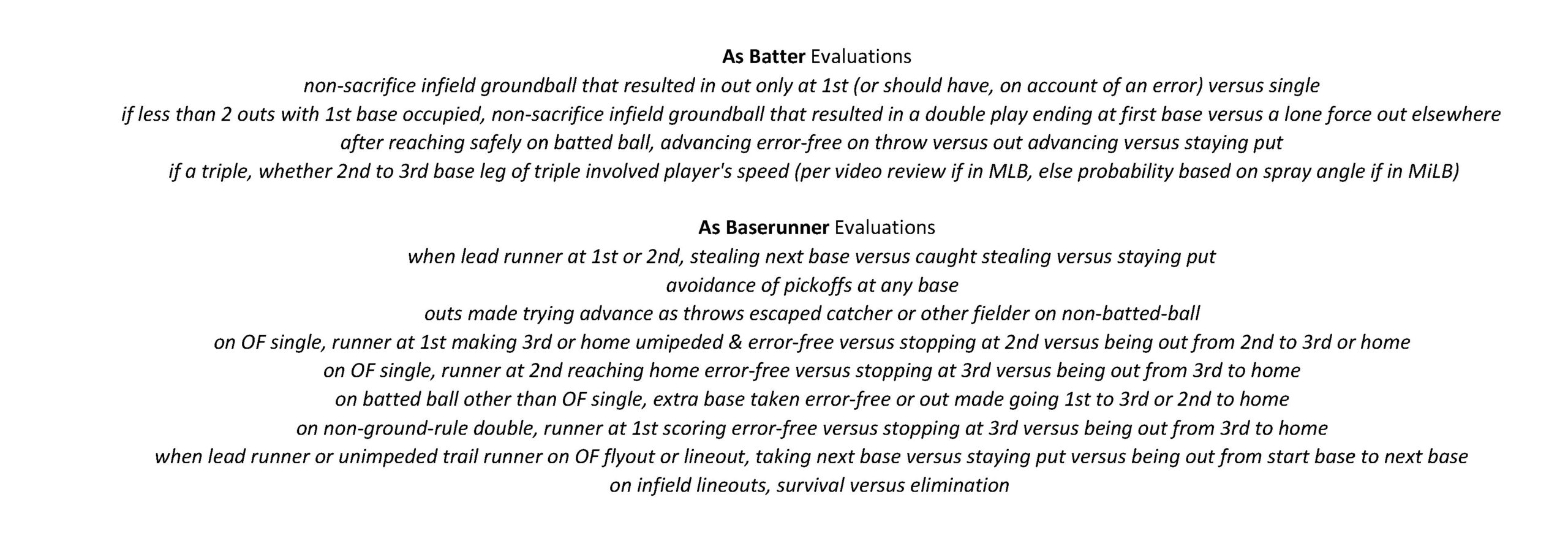
Prospect Analysis: Ben Williamson
Evolution of College Plate Profile
The global pandemic aborted the freshman 2020 season of Williamson at William & Mary. He would play three fuller D1 seasons for the college after that. The first of three summer wood bat league stints that began in 2021 is not referenced in the subsequent plate profile tables.
Williamson stood out positively on K Avoid grounds alone until the 2022 summer league trip. Then he began to flash a better LD + IFFB Avoid + Pull GB Avoid Hit trio versus the past that paved way to some subtler AVG on Batted Balls gains. The improved hit trio carried over to the next super junior spring season and fueled an above plus (90) AVG on Batted Balls.
Meanwhile, that hit trio and relatively more OFFB and Pull OFFB versus 2022 enabled not quite plus (81) ISO production. A career best 92 BB+HBP further contributed to an outstanding 99 Overall Rating.
The draftable-for-a-second-time collegian from a mid-major program sought to further improve his 2023 MLB Draft stock by reporting early to the summer Cape Cod League. A fantastic hit trio buoyed a 98 AVG on Batted Balls while a 46 ISO better matched the OFFB and Pull OFFB Ratings than the 2023 D1 ISO did. BB+HBP fell more than K Avoid did over those 39 wood-bat PA against top college pitchers.
Having already extended above-slot bonuses to prep position players Colt Emerson and Jonny Farmelo at earlier selections of the 2023 MLB Draft, the Mariners lined up the strikeout-averse, improving hitter as their 2nd Round 57th overall pick at a $600,000 bonus that would net them $840,000 in bonus pool savings.
Evolution of Pro Plate Profile
Over just 44 pro debut plate trips that began in Rookie-level Arizona Complex League and ended in Low-A California League, Williamson posted a lopsidedly-LD-leaning hit trio that produced an average dose (58) of AVG on Batted Balls.
BB+HBP and K Avoid fell still further in the two-league pro debut relative to the already down summer wood bat league marks.
A 130 PA High-A start to 2024 saw (70) BB+HBP and (94) K Avoid return to loftier D1 standards. The hit trio of batted ball profile reflected better balance between LD and Pull GB Avoid and the corresponding 90 AVG on Batted Balls was somewhat but not overly high per the Path fundamentals.
The 50 ISO mark was very high per that a 46 OFFB was accompanied by only a 2 Pull OFFB, which reflects that his OFFB contact was very seldom earlier in swing timing.
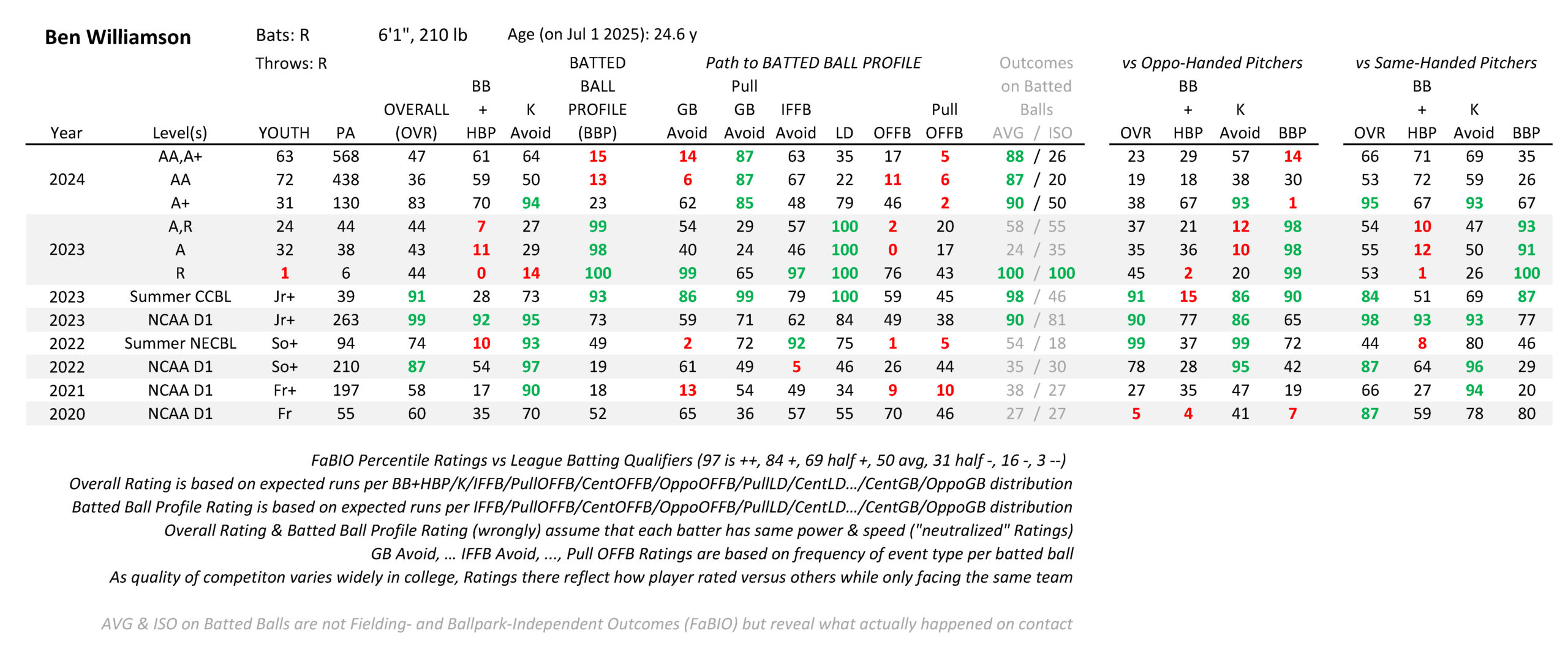 Most of his 2024 season was spent in Double-A, where he logged 438 plate trips. While BB+HBP did not change much versus High-A, K Avoid was down a surprising 1.5 standard deviations to a circuit-average 50 in Double-A versus the earlier High-A mark.
Most of his 2024 season was spent in Double-A, where he logged 438 plate trips. While BB+HBP did not change much versus High-A, K Avoid was down a surprising 1.5 standard deviations to a circuit-average 50 in Double-A versus the earlier High-A mark.
Batted ball launch angles dropped a lot in Double-A per the 2024 between-level disparities in GB Avoid and OFFB. Williamson continued to produce a plus (87) AVG on Batted Balls despite a large decline in the LD portion of the hit trio.
Such could be explained by some combo of higher exit velocities or relatively higher launch angles within a larger subset of the GB. A just above minus (20) ISO was itself an overachievement per such low OFFB and Pull OFFB Ratings.
Besides that, the large sample of Double-A batted ball outcomes were relatively louder in AVG and ISO than they should have been per the Path to Batted Ball Profile fundamentals, and the pitcher handedness splits to the right end of the table merit some attention. Williamson sports "backward splits" as he has posted a better Overall versus Same-Handed Pitchers than versus Oppo-Handed Pitchers at all four pro stops.
Williamson logged 19 plate trips in the 2025 MLB spring games. BB+HBP and K Avoid improved relative to the Double-A marks with each registering in the range of half to full plus.
The 13 MLB spring batted balls produced Path to Batted Ball Profile fundamentals and AVG and ISO Ratings that remarkably resembled the large-sample Double-A precedents aside from some increased loft in March (per GB Avoid and OFFB Ratings). Again he had produced much more AVG and more ISO than a typical batter would with the same fundamentals.
Evolution of Pro Offensive Running
A large sample of 2024 plays across two levels paints Williamson as a (very) solidly average offensive runner who plays about as fast as Batter as he does as Baserunner.
Dynasty Fantasy Baseball Focus
Williamson sports a clearer hit-over-power bias now per his recent run of batted ball profiles. Just how much batting average on batted balls his better (LD + IFFB Avoid + Pull GB Avoid) hit trio produces should hinge on line drive frequency.
In 2024 Double-A he was able to maintain a beyond plus batting average on batted balls despite larger losses of line drives versus High-A. Even after pulling off the same trick again over a very tiny sample of 2025 MLB Spring plate appearances, conjuring up such black magic in an MLB regular season is difficult.
Defensively, Williamson profiles as a good-gloved, good-armed third baseman who could spot start or relieve late at shortstop plus play a quality second base to accommodate getting a third-base-only player into the lineup.
A club that started him at third would sacrifice corner infield extra bases production since he very seldom hits pull-third outfield flyballs; they would likely aim to offset that deficit by getting relatively more extra bases production from other defensive positions.
Williamson seems surer to avoid strikeouts in MLB better than he tallies walks plus hit-by-pitches. The projected shortage of extra bases production effectively discourages pitchers, catchers, and coaching staffs from nibbling much around the fringes of his strike zone.
Pro plate profiles cast Williamson as needing to improve his approach, swing, etc. against opposite-handed pitchers. Today, the righthanded batter is better equipped to start else pinch-hit from the bench versus righthanded rather than lefthanded pitchers.
Fantasy players should value Williamson as a potential part-time MLB regular third baseman and second baseman whose projected strengths are strikeout avoidance, hitting some to more singles else doubles, and multifaceted infield defense.
Download Our Free News & Alerts Mobile App
Like what you see? Download our updated fantasy baseball app for iPhone and Android with 24x7 player news, injury alerts, sleepers, prospects & more. All free!

More Fantasy Baseball Advice





 RADIO
RADIO









